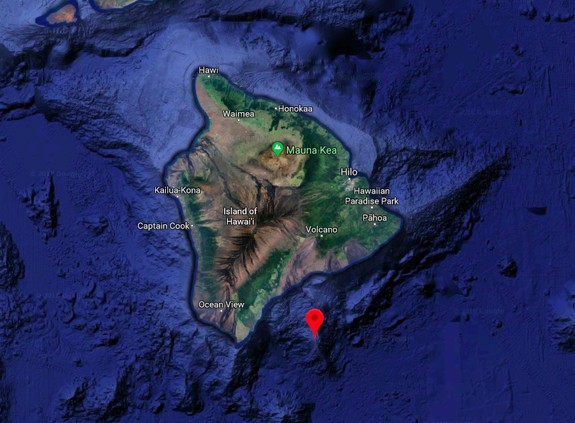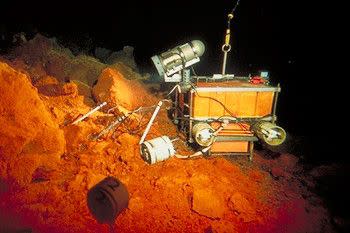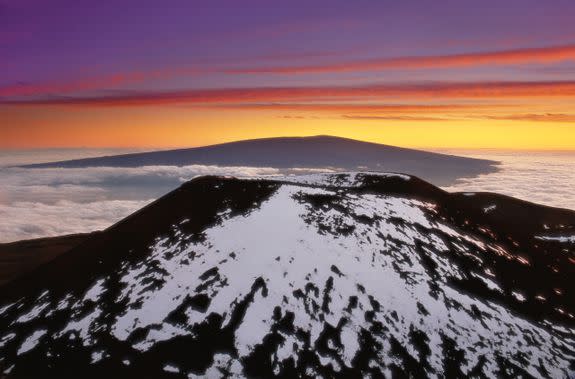Deep beneath the Pacific, another active Hawaiian volcano waits to emerge

As Hawaii's Kilauea volcano continues to spew lava into neighborhoods and eject foreboding plumes of dark ash into the sky, a nearby underwater volcano named Lo‘ihi patiently waits to rise above the surface.
Like all Hawaiian volcanoes, dead and alive, Lo‘ihi has grown steadily from the depths of the Pacific Ocean as lava spews from it and quickly cools, slowly adding more mass to the underwater mountain.
If Lo‘ihi keeps erupting lava, gradually building up its surface area, the active volcano could very well become Hawaii's next Big Island volcano. It's also possible that the volcano could even start its own, brand new Hawaiian island.
SEE ALSO: An astronaut saw Hawaii's Kilauea volcano erupting from space. And he took a picture.
"There's every reason to believe this will be the latest chapter in this story going back millions of years," George Bergantz, a volcanologist at the University of Washington, said in an interview.
Volcano scientists, including those at the U.S. Geological Survey (USGS), consider Lo‘ihi to be an active volcano, because it has erupted in recent history.
The USGS lists Lo‘ihi as having a "very low" threat potential, as it's more than 3,000 feet beneath the Pacific.

Image: Google Maps
"It's definitely an active or potentially active volcano," Erik Klemetti, a volcanologist at Denison University, said in an interview. "But it's hard to be there at the right time to see it [an eruption] happen."
In 1996, Lo‘ihi experienced "a pretty significant eruption," Michael Poland, of the USGS's Yellowstone Volcano Observatory, said in an interview. Poland noted that the dramatic, undersea eruption collapsed a portion of the seamount's summit.
Although no one directly witnessed the eruption — as that would mean waiting in a deep-sea submersible at a reasonable distance away — scientists still knew about it. Lo‘ihi sits on the side of the Big Island, so the strong earthquakes that typically accompany eruptions were picked up by Hawaii's seismic monitoring instruments.
"It was one of the most energetic earthquake swarms that we had ever seen in Hawaii," Jackie Caplan-Auerbach, an associate professor of geology at Western Washington University, said in an interview.
Caplan-Auerbach spent a couple years directly studying Lo‘ihi, floating above it in a research vessel and once even taking a submersible down to the volcano.

Image: NOAA/NOAA Undersea research program
"I was hoping to see something," she said, but it appears that since the dramatic 1996 eruption, Lo‘ihi has quieted down — for now.
The year after the quake, scientists placed a large, refrigerator-sized "submarine volcano observatory" on Lo‘ihi's summit, connected to shore by a long circuit. It soon stopped working but still provided Caplan-Auerbach and other scientists with months of valuable data.
"We saw very little, which was weird," she said. "It was probably the end of a fairly active period."
What will become of Lo‘ihi?
Each of the Hawaiian islands is composed of at least one volcano.
The Big Island is made up of five, some of which, like 12,000-foot high Moana Loa, are massive, gently-sloping mountains.
"As Moana Loa is today, Lo‘ihi may one day be," Bergantz said, but noted that this isn't, of course, a sure thing. This seamount still has a lot of erupting to do to even breach the surface.
No one has any real idea how long it might take for Lo‘ihi to emerge, but the USGS estimates that if Lo‘ihi continues to layer lava on its summit and flanks at the rate of about 16.5 feet every 1,000 years, the volcano will emerge in some 200,000 years.

Image: Getty Images/Mint Images RM
Caplan-Auerbach has a similar estimate but said that we don't really know how quickly the mountain will grow. Scientists first started monitoring it in the 1970s.
"For geologists, this is crazy short," she said. "So we’ll have to wait and see if it does anything exciting."
There has been some small quaking activity down there, in around 2000, 2004, and again last year, Caplan-Auerbach said. So perhaps Lo‘ihi is due for some more truly eruptive activity.
However, the 1996 didn't help Lo‘ihi's island ambitions any.
"The last thing it did was shrink," said Caplan-Auerbach said, referring the the summit collapse in 1996. "It's got to kick into gear if it wants to get into island mode."
"Don’t buy property there."
Related Video: Hawaii's Kilauea Volcano Erupts
Watch news, TV and more on Yahoo View.
WATCH: Exploring volcanoes with robots: a day in the life of Carolyn Parcheta

